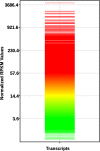Next generation sequencing and de novo transcriptome analysis of Costus pictus D. Don, a non-model plant with potent anti-diabetic properties
- PMID: 23176672
- PMCID: PMC3533581
- DOI: 10.1186/1471-2164-13-663
Next generation sequencing and de novo transcriptome analysis of Costus pictus D. Don, a non-model plant with potent anti-diabetic properties
Abstract
Background: Phyto-remedies for diabetic control are popular among patients with Type II Diabetes mellitus (DM), in addition to other diabetic control measures. A number of plant species are known to possess diabetic control properties. Costus pictus D. Don is popularly known as "Insulin Plant" in Southern India whose leaves have been reported to increase insulin pools in blood plasma. Next Generation Sequencing is employed as a powerful tool for identifying molecular signatures in the transcriptome related to physiological functions of plant tissues. We sequenced the leaf transcriptome of C. pictus using Illumina reversible dye terminator sequencing technology and used combination of bioinformatics tools for identifying transcripts related to anti-diabetic properties of C. pictus.
Results: A total of 55,006 transcripts were identified, of which 69.15% transcripts could be annotated. We identified transcripts related to pathways of bixin biosynthesis and geraniol and geranial biosynthesis as major transcripts from the class of isoprenoid secondary metabolites and validated the presence of putative norbixin methyltransferase, a precursor of Bixin. The transcripts encoding these terpenoids are known to be Peroxisome Proliferator-Activated Receptor (PPAR) agonists and anti-glycation agents. Sequential extraction and High Performance Liquid Chromatography (HPLC) confirmed the presence of bixin in C. pictus methanolic extracts. Another significant transcript identified in relation to anti-diabetic, anti-obesity and immuno-modulation is of Abscisic Acid biosynthetic pathway. We also report many other transcripts for the biosynthesis of antitumor, anti-oxidant and antimicrobial metabolites of C. pictus leaves.
Conclusion: Solid molecular signatures (transcripts related to bixin, abscisic acid, and geranial and geraniol biosynthesis) for the anti-diabetic properties of C. pictus leaves and vital clues related to the other phytochemical functions like antitumor, anti-oxidant, immuno-modulatory, anti-microbial and anti-malarial properties through the secondary metabolite pathway annotations are reported. The data provided will be of immense help to researchers working in the treatment of DM using herbal therapies.
Figures









References
-
- American Diabetes Association. Diagnosis and classification of diabetes Mellitus. Diabetes Care. 2004;27(1):S5–S10. - PubMed
-
- Chawla S, Gupta D, Tiwari A. Type 2 diabetes in the wake of insulin resistance: Molecular etiology and therapeutics. J Pharm Res. 2011;4:4.
-
- Jayasri MA, Radha A, Mathew TL. α-amylase and α-glucosidase inhibitory activity of Costus pictus D. Don in the management of diabetes. J Herb Med Toxicol. 2009;3(1):91–94.
-
- Benny M. Preparation, process and a regenerative method and technique for prevention, treatment and glycemic control of diabetes mellitus. 2008. US patent No: US7939114.
MeSH terms
Substances
LinkOut - more resources
Full Text Sources
Medical

